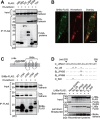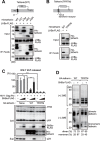Molecular dissection of HBV evasion from restriction factor tetherin: A new perspective for antiviral cell therapy
- PMID: 26334101
- PMCID: PMC4673130
- DOI: 10.18632/oncotarget.4808
Molecular dissection of HBV evasion from restriction factor tetherin: A new perspective for antiviral cell therapy
Abstract
Viruses have evolved various strategies to escape from the innate cellular mechanisms inhibiting viral replication and spread. Extensive evidence has highlighted the ineffectiveness of interferon (IFN) therapy against chronic hepatitis B virus (HBV) infection, implying the existence of mechanisms by which HBV evades IFN-induced antiviral responses. In our current study, we demonstrate that HBV surface protein (HBs) plays a crucial role in counteracting the IFN-induced antiviral response mediated by tetherin (also known as BST-2). The type I IFN treatment of HBV-producing cells marginally but significantly inhibited the release of HBsAg and viral DNA, but this release was recovered by the knockdown of tetherin. HBs can interact with tetherin via its fourth transmembrane domain thereby inhibiting its dimerization and antiviral activity. The expression of a tetherin mutant devoid of the HBs-binding domain promoted a prominent restriction of HBV particle production that eventually resulted in the alleviation of caspase-1-mediated cytotoxicity and interleukin-1β secretion in induced pluripotent stem cell (iPSC)-derived hepatocytes. Our current results thus reveal a previously undescribed molecular link between HBV and tetherin during the course of an IFN-induced antiviral response. In addition, strategies to augment the antiviral activity of tetherin by impeding tetherin-HBs interactions may be viable as a therapeutic intervention against HBV.
Keywords: Immune response; Immunity; Immunology and Microbiology Section; hepatic injury; pyroptosis.
Conflict of interest statement
No, there is no conflict of interest.
Figures






Similar articles
-
The Interferon-Inducible Protein Tetherin Inhibits Hepatitis B Virus Virion Secretion.J Virol. 2015 Sep;89(18):9200-12. doi: 10.1128/JVI.00933-15. Epub 2015 Jun 24. J Virol. 2015. PMID: 26109732 Free PMC article.
-
Toll-like receptor 7 agonist GS-9620 induces prolonged inhibition of HBV via a type I interferon-dependent mechanism.J Hepatol. 2018 May;68(5):922-931. doi: 10.1016/j.jhep.2017.12.007. Epub 2017 Dec 13. J Hepatol. 2018. PMID: 29247725
-
Identification of BST-2/tetherin-induced hepatitis B virus restriction and hepatocyte-specific BST-2 inactivation.Sci Rep. 2015 Jun 29;5:11736. doi: 10.1038/srep11736. Sci Rep. 2015. PMID: 26119070 Free PMC article.
-
Molecular virology of hepatitis B virus and targets for antiviral intervention.Intervirology. 2014;57(3-4):134-40. doi: 10.1159/000360946. Epub 2014 Jul 15. Intervirology. 2014. PMID: 25034480 Review.
-
[Inhibition of HBV Release by BST-2].Bing Du Xue Bao. 2016 Mar;32(2):215-21. Bing Du Xue Bao. 2016. PMID: 27396167 Review. Chinese.
Cited by
-
The tumour suppressor APC promotes HIV-1 assembly via interaction with Gag precursor protein.Nat Commun. 2017 Jan 30;8:14259. doi: 10.1038/ncomms14259. Nat Commun. 2017. PMID: 28134256 Free PMC article.
-
Epigenetic Regulation of BST-2 Expression Levels and the Effect on HIV-1 Pathogenesis.Front Immunol. 2021 May 5;12:669241. doi: 10.3389/fimmu.2021.669241. eCollection 2021. Front Immunol. 2021. PMID: 34025670 Free PMC article.
-
The role of BST-2/Tetherin in host protection and disease manifestation.Immun Inflamm Dis. 2015 Dec 7;4(1):4-23. doi: 10.1002/iid3.92. eCollection 2016 Mar. Immun Inflamm Dis. 2015. PMID: 27042298 Free PMC article. Review.
-
Prolyl Isomerase Pin1 Regulates the Stability of Hepatitis B Virus Core Protein.Front Cell Dev Biol. 2020 Jan 31;8:26. doi: 10.3389/fcell.2020.00026. eCollection 2020. Front Cell Dev Biol. 2020. PMID: 32083080 Free PMC article.
-
Immune Evasion Strategies during Chronic Hepatitis B and C Virus Infection.Vaccines (Basel). 2017 Sep 1;5(3):24. doi: 10.3390/vaccines5030024. Vaccines (Basel). 2017. PMID: 28862649 Free PMC article. Review.
References
Publication types
MeSH terms
Substances
LinkOut - more resources
Full Text Sources
Other Literature Sources

